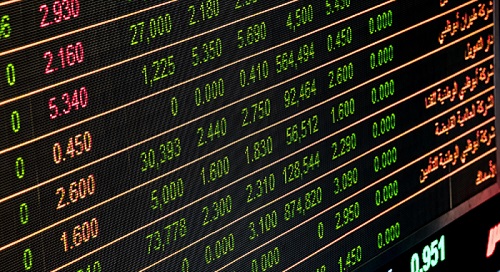Like on other walks of life, there is a huge and threatening Impact of Coronavirus on the World Economy as well. This article focuses on the powerful and adverse Impact of Coronavirus on the World Economy after terribly damaging the International Stock Market.
After being to a great extent overlooked Covid-19 as it spread across China, worldwide finance and economy related markets responded firmly when the infection spread to Europe and the Middle East, feeding fears of a worldwide pandemic. From that point forward, Covid-19 dangers have been estimated so forcefully across different resource classes that some dread a downturn in the worldwide economy might be an inescapable result.

In our discussions, business pioneers are asking whether the market drawdown genuinely flags a downturn and recession, how awful a Covid-19 downturn would be, what the situations are for development and restoration, and whether there will be any enduring basic effect from the rising emergency situation.
In fact, projections and lists won’t answer these inquiries. Barely dependable in the calmest of times, a GDP figure is questionable when the infection direction is mysterious, similar to the viability of control endeavors, and consumers’ and firms’ responses. There is no single number that soundly catches or anticipates Covid-19’s financial as economic effect.
Rather, we must carefully investigate and observe the market indicators across resource classes, downturn and recuperation designs, just as the historical backdrop of shocks and epidemics, to gather bits of knowledge into the way forward.
A week ago’s severe drawdown in worldwide money related markets may appear to demonstrate that the world economy is on a way to downturn. Valuations of safe resources have arisen forcefully, with the term premium on long-dated U.S. government bonds tumbling to reach remarkable lows at negative 116 basis points — that is how a lot of capital investors are eager to pay for the protected harbor of U.S. government obligation. Subsequently, mechanical models of downturn hazard have grown higher.

However, a more critical look uncovers that a downturn ought not to be viewed as an inevitable end product.
In the first place, take valuations of hazard resources, where the effect of Covid-19 has not been harmonious. On the milder aspect, credit spreads have grown strikingly small, proposing that credit markets don’t yet predict subsidizing and financing issues. Valuations of equity have obviously tumbled down from recently achieved heights, yet it ought to be noticed that they are as yet raised comparative with their more long-term history. On the opposite side to it, unpredictability has flagged the best strain, irregularly putting expected one month instability comparable to any of the significant displacement of the previous 30 years, outside of the worldwide budgetary emergency.
Second, while money related markets are a significant downturn pointer (not least since they can likewise cause them), history shows that bear markets and downturns ought not be naturally conflated. In actuality, the overlapping cover is just around two out of each three U.S. bear markets — as such, one out of each three bear markets is non-recessionary. In the course of the most recent 100 years, seven such cases were checked where bear markets didn’t agree with downturns.
There is no uncertainty that monetary markets currently attribute critical problematic potential to Covid-19, and those dangers are genuine. Be that as it may, the varieties in resource valuations underline the noteworthy vulnerability encompassing this plague, and history alerts us against drawing a straight line between budgetary market sell-offs and the genuine economy.
Covid-19-Induced Recession—How will it Look Like?
In spite of the fact that sentiments prevailing in the market can be deceiving, recessionary hazard is genuine. The weakness of bigger economies, including the U.S. economy, has ascended as development has eased back and the extensions of different nations are currently less ready to retain stuns and shocks. Indeed, an exogenous stun impacting the U.S. economy during a period of powerlessness has been the most conceivable recessionary situation for quite a while.
Downturns particularly can be categorized as one of three classes:
• Real Recession: Traditionally, this is a CapEx boom cycle that goes to bust and wrecks the extension. However, extreme exogenous interest and supply stuns —, for example, wars, calamities, or different disturbances — can likewise drive the genuine economy into a withdrawal. It’s here that Covid-19 has the best opportunity to contaminate its host.
• Policy Recession: At the point when national banks leave policy rates excessively high comparative with the economy’s “unbiased” or “neutral” rate, they harden money related conditions and credit intermediation, and, with a slack, choke off the development to the extent of a total jeopardy. This hazard stays mild and unobtrusive — outside of the U.S. rates are rock bottom already or even negative, while the Federal Reserve has conveyed an unexpected cut of 50 basis points. Outside of the financial policy reaction, the G7 ministers of finance have likewise promised monetary help.
• Financial Crisis: Money related lopsided characteristics will in general develop gradually and over significant stretches of time, before quickly loosening up, disturbing monetary intermediation and afterward the genuine economy. There are some identifiable contrasts internationally, yet in the critical U.S. economy, money related emergency dangers are hard to highlight. A few reporters point to the air pocket in corporate credit, as observed in huge issuance and tight spreads. However, battle is fought with the subprime contrast and analogy of the last downturn, as corporate credit neither finances a genuine economy blast (as subprime did with lodging and housing), nor is the obligation hung on banks’ asset reports. The two variables limit the foundational danger of a potential shakeout in credit, however this hazard can’t be expelled totally. It’s hard to see Covid-19 adding to monetary irregular and lopsided characteristics, yet stress could emerge from income strains, specific in little and medium enterprises (SMEs).
Taking a gander at this scientific categorization, and again at history, there is some uplifting news in the “real economy” arrangement. In spite of the fact that eccentric, genuine downturns will in general be milder than either strategy downturns or those instigated by monetary emergency, as they speak to possibly extreme yet basically transient interest (or supply) shocks. Strategy downturns, on the other hand, can be, contingent upon the size of the mistake, extreme. Actually, the Great Depression was incited by perhaps the biggest strategy blunder ever. Also, financial emergencies are the most noxious kind, since they bring auxiliary issues into the economy that can set aside a long effort to be remedied.
What is the Potential Recovery Way?
Regardless of whether economies can stay away from the downturn or not, the way back to development under Covid-19 will rely upon a variety of drivers, for example, how much requirement will be postponed or left out, whether the stun is genuinely a spike or keeps going, or whether there is auxiliary harm, among various factors. It’s sensible to portray three expansive situations, which we depicted as V-U-L.
• V-shaped: This situation depicts the “classic” genuine economy stun, a removal of yield, however development in the long run bounce back. Right now, development rates could completely retain the stun. In spite of the fact that it might appear to be idealistic in the midst of the present unhappiness, we think it is conceivable.
• U-shaped: This situation is the revolting sibling and bad kin of V — the stun keeps going on, and keeping in mind that the underlying development way is continued, there is some lasting loss of final output. Is this conceivable for Covid-19? Completely, yet we’d need to see more proof of the infection’s genuine harm to make this the base case.
• L-shaped: This situation is the monstrous, much bitter and poor connection of V and U. For this to appear, you’d need to have confidence in Covid-19’s capacity to do critical auxiliary harm, for example breaking something on the economy’s stockpile and supply side — the work market, capital development, or the profitability work. This is hard to envision even with cynical suspicions. Sooner or later the world will be on the opposite side of this plague.
Once more, it merits glancing back at history to put the potential effect way of Covid-19 on the basis of verifiable exactitude. Indeed, V-shapes hoard the observational scene of earlier stuns, including pandemics, for example, SARS, the 1968 H3N2 (“Hong Kong”) influenza, 1958 H2N2 (“Asian”) flu, and 1918 Spanish influenza and flu.
Any Permanent Economic Results and Consequences of Covid-19?
To get this, we have to look at the transmission instrument through which the health emergency contaminates the economy.
In the event that the scientific taxonomy of downturns reveals to us where the infection likely assaults the economy, transmission channels disclose to us how the infection assumes responsibility for its host. This is significant since it suggests various effects and cures. There are three conceivable transmission channels:
• Indirect hit to confidence (wealth impact): An exemplary transmission of exogenous stuns to the genuine economy is through money related markets (and all the more extensively monetary conditions) — they become some portion of the issue. As business sectors fall and family riches contracts, family unit investment funds rates go up and in this manner utilization must fall. This impact can be incredible, especially in cutting edge economies where family unit introduction to the value resource class is high, for example, the U.S. All things considered, it would take both a precarious (more bear market than amendment) and continued decline.
• Direct hit to consumer confidence: While monetary market execution and purchaser certainty relate unequivocally, since a long-run information additionally shows that buyer certainty can drop in any event, when markets are up. Covid-19 has all the earmarks of being a conceivably intense direct hit on certainty, keeping purchasers at home, fatigued of optional spending, and maybe critical about the more extended time period.
• Supply-side shock: The two channels mentioned above are demand shocks, however there is extra transmission chance by means of supply disturbance. As the infection closes down creation and cripples basic parts of supply chains, gaps and spaces grow into bigger and more formidable issues, production could stop, leaves of absence and cutbacks could happen. There will be immense changeability across economies and businesses, yet taking the U.S. economy for instance, we figure it would take a serious delayed emergency for this to take care of through in a huge manner. Comparative with the need effect, we consider this to be optional instead of something primary and compulsory.
Downturns or recessions are mostly repetitive, not composition-based, occasions and happenings. But then the limit can be obscured. To outline, the worldwide budgetary emergency was a (exceptionally awful) repetitive and patterned happening in the U.S., yet it had a basic protrusions. The economy bounced back, yet family deleveraging is a continuous mainstream event— family’s readiness (and capacity) to acquire is fundamentally damaged, and the inadvertent blow-back, basically, is that strategy creators think that its a lot harder to push the cycle just by overseeing transient loan costs today.
Could Covid-19 make its own basic legacy? History proposes that the worldwide economy after a significant emergency like Covid-19 will probably be diverse in various critical manners.
• Microeconomic legacy: Crises, including pestilences, can spike the appropriation of new advances and plans of action. The SARS flare-up of 2003 is frequently credited with the selection of web based shopping among Chinese customers, quickening Alibaba’s ascent. As schools have shut in Japan and could conceivably shut in the U.S. also, different markets, could e-learning and e-conveyance of training see a leap forward? Further, have computerized endeavors in Wuhan to contain the emergency through advanced mobile phone trackers adequately showed an incredible new general public health device?
• Macroeconomic legacy: Already it appears that the infection will rush the advancement to increasingly decentralized worldwide value chains — basically the infection adds a natural measurement to the political and institutional powers that have pushed the pre-2016 worth chain model into a progressively divided direction.
• Political legacy: Political repercussions are not to be precluded, internationally, as the infection scrutinizes different political frameworks’ capacity to adequately ensure their populaces. Fragile foundations could be uncovered, and political movements activated. Contingent upon its span and seriousness, Covid-19 could even shape the U.S. presidential political race. At the multilateral level, the emergency could be perused as a call to more collaboration or then again drive the bipolar focuses of geopolitical force further separated.
What Leaders Can Do in Relation to Economic Risks?
The experiences from money related markets and the historical backdrop of analogues to stuns and shocks can be operationalized as below:
• Don’t depend wholly on projections: Monetary markets are as of now reflecting extraordinary vulnerability. A wide scope of situations stays conceivable and ought to be investigated by organizations.
• Don’t permit monetary markets gyrations to generate or accumulate judgment about the business you lead.
• Focus on customer certainty signals; trust your own impulses, and ability to use your organization’s information in adjusting such bits of knowledge. The effect won’t be uniform, and the ends will be particular to and focused on your industry.
• Be ready with plans for both gain and loss. Plan generally advantageous and get ready for the most noticeably terrible directions. Remember that a V-molded recuperation is the conceivable situation theoretically and experimentally, yet don’t let that knowledge make you self-satisfied.
• Begin to look past the emergency. What smaller scale or macroeconomic or heritage will Covid-19 have? What openings or difficulties will emerge?
• Consider how you will address the post-emergency world. Would you be able to be a piece of quicker reception of new innovations, new procedures, and so forth? Could you in the long run discover advantage in misfortune for your organization, customers and society?
If you have any suggestions or questions regarding Impact of Coronavirus on the World Economy, please don’t hesitate to leave your feedback in the comment section below. Thanks!
Find Us
https://www.facebook.com/ewriter29/
Relevant Post
https://www.ewriter29.com/trending/some-symptoms-of-coronavirus/



